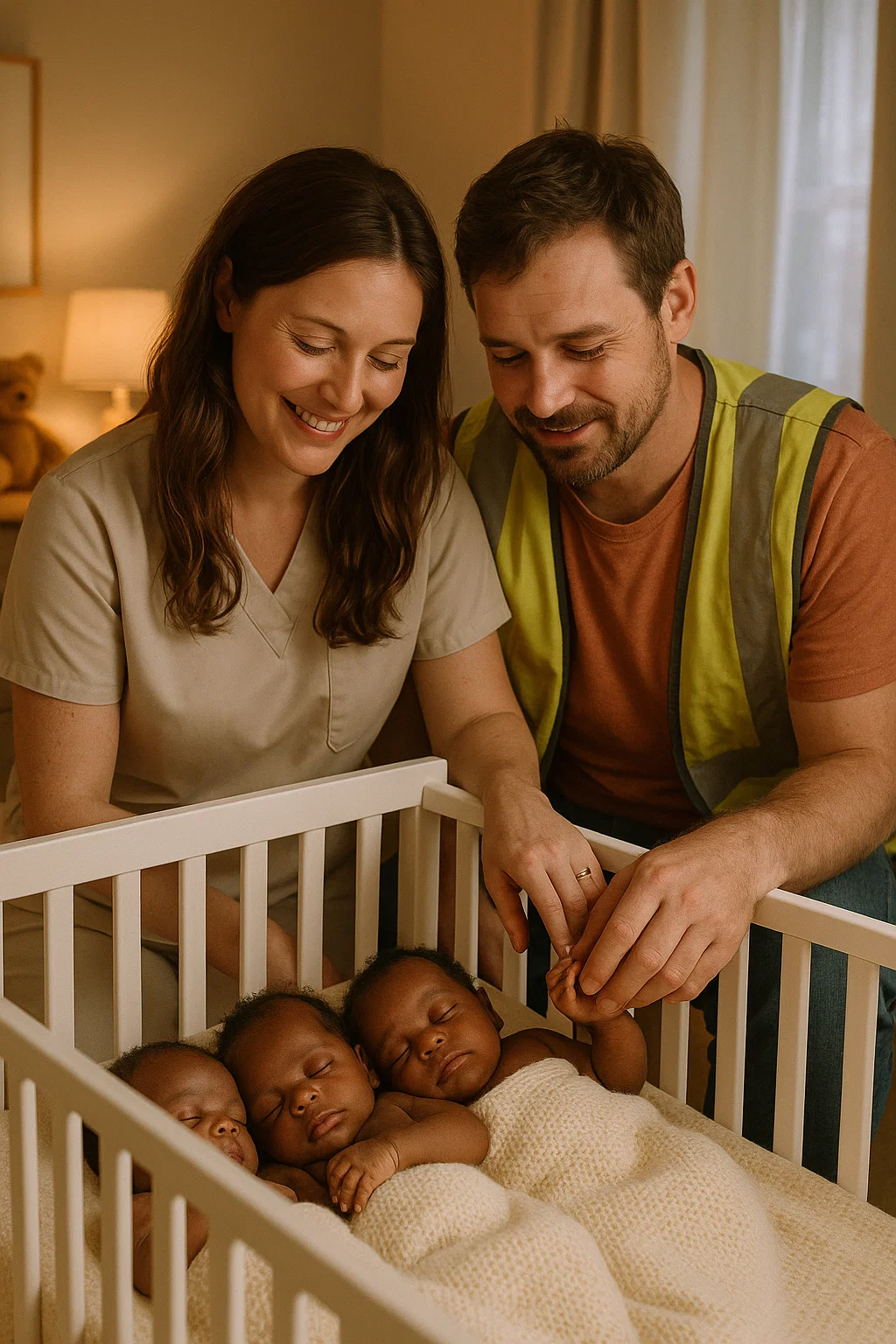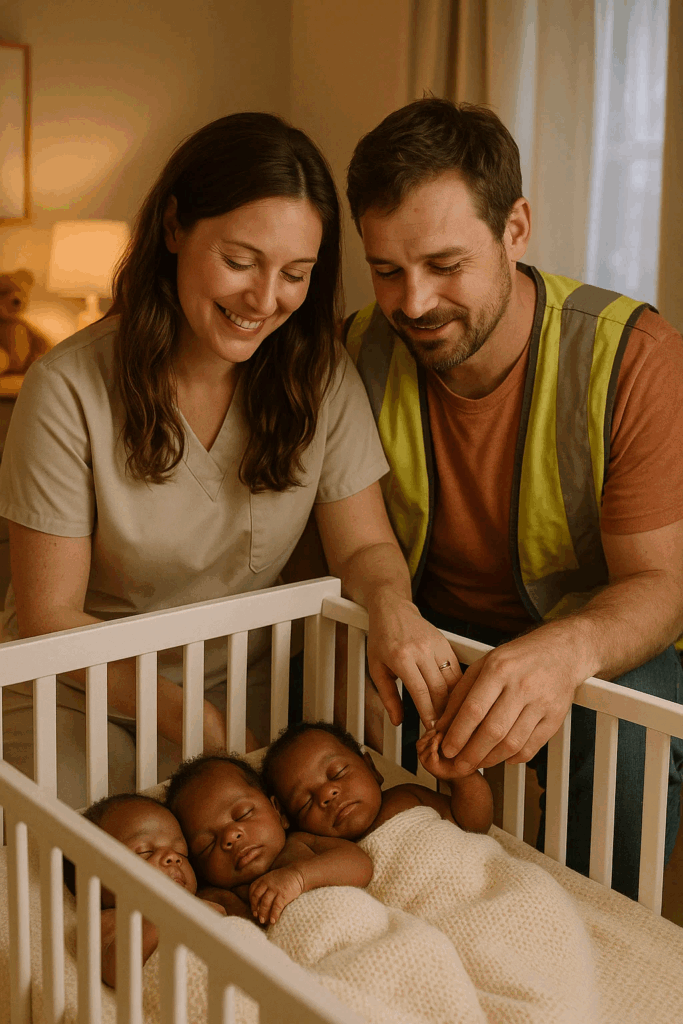Rejected at Birth — What Happened to Three Children 16 Years Later?…
In 2007, in a small countryside hospital, Claire Thompson lay weak from labor but holding onto life as three tiny babies were placed in her arms. Triplets—rare enough to make nurses whisper. But what truly unsettled the room was their appearance: soft brown skin, in stark contrast to Claire’s pale complexion and her husband Mark’s fair features.
 The staff murmured in confusion. Claire looked down at her newborns with trembling hands, her heart already aching. Mark stood at the foot of the bed, staring at the babies with disbelief hardening into anger.
The staff murmured in confusion. Claire looked down at her newborns with trembling hands, her heart already aching. Mark stood at the foot of the bed, staring at the babies with disbelief hardening into anger.
“This isn’t possible,” he muttered. His voice rose. “Don’t tell me they’re mine.”
Claire’s lips quivered. “They are, Mark. They’re ours.”
But he shook his head, his jaw tightening. “No. You’ve humiliated me. I won’t raise them.” Within hours, the paperwork was signed. Against medical reassurances and any logical explanation, Mark and Claire abandoned the children—two girls and a boy—at the maternity ward. By evening, they were gone.
The babies remained under the hospital’s care, their cries echoing in the nursery. The staff did their best, but whispers spread: Who would take three infants at once? Some doubted any family would step forward, especially given the gossip about their skin color.
Yet destiny brought someone unexpected. A week later, Daniel and Margaret Evans—a middle-aged couple who had struggled with infertility—arrived at the ward. Daniel, a construction supervisor, and Margaret, a nurse in a nearby town, had long dreamed of children. When they saw the three newborns sleeping together in a crib, their hearts swelled.
“They’re siblings,” Margaret said firmly. “We take all three. They deserve to stay together.”
Within a month, the adoption was finalized. The triplets went home with the Evans family, carrying with them the scars of rejection—but also the promise of a new beginning.
Life in the Evans household was chaotic but full of love. The babies were named James, Sophia, and Mia. The early months blurred into sleepless nights, endless bottles, and diapers stacked high. Yet for Daniel and Margaret, it was everything they had prayed for.
Neighbors sometimes cast curious looks. A white couple raising three black triplets stood out in their small town. Whispers lingered at grocery stores, and strangers occasionally asked intrusive questions. Daniel’s answer never wavered: “They’re our children.” Margaret, gentle but firm, shut down gossip quickly.
As toddlers, each child’s personality blossomed. James, the only boy, was calm and observant, often protecting his sisters when they cried. Sophia, curious and fearless, explored every corner of the house. Mia, quieter and sensitive, clung to Margaret’s side but surprised everyone with her determination when she wanted something.
By preschool, they were inseparable. Teachers praised their bond and the warmth of their home life. But the shadow of abandonment lingered. One afternoon, James—barely ten years old—asked, “Mom, did our first parents not want us?” Margaret knelt down, brushing his hair gently. “They weren’t ready. But Dad and I chose you. You are ours, and that’s what matters.”
The truth weighed on the children differently. Sophia grew defiant, channeling her energy into sports. Mia sought comfort in music, practicing violin until late evenings. James tinkered with electronics, spending hours in the garage with Daniel.
Though challenges persisted—awkward stares, cruel remarks from a few peers—the Evans family stood united. Birth history might have marked them, but love defined them.
By the time they turned sixteen, the triplets were no longer defined by whispers but by achievements. James, thoughtful and inventive, had won awards in robotics competitions. Sophia, unstoppable on the track, dreamed of a college athletic scholarship. Mia, once shy, played the violin on regional stages, her music earning admiration from beyond their town.
At home, dinner was often noisy—stories from practice, the hum of a half-built robot, the sound of violin scales echoing down the hall. Daniel and Margaret exchanged smiles across the table, remembering the uncertainty of that first day in the maternity ward.
The question of their birth parents sometimes resurfaced. “Did they ever try to find us?” Mia asked once. Margaret shook her head softly. “No letters, no calls. But that doesn’t change who we are. We’re a family.”
And the triplets agreed. Their beginnings were complicated, but their present was rich with love, laughter, and opportunity. What once seemed like a cruel rejection had become the foundation of something extraordinary: three children raised in a home that never doubted them.
Sixteen years after being left behind, the triplets weren’t victims of abandonment—they were proof that family is not defined by blood, but by those who choose to stay.


